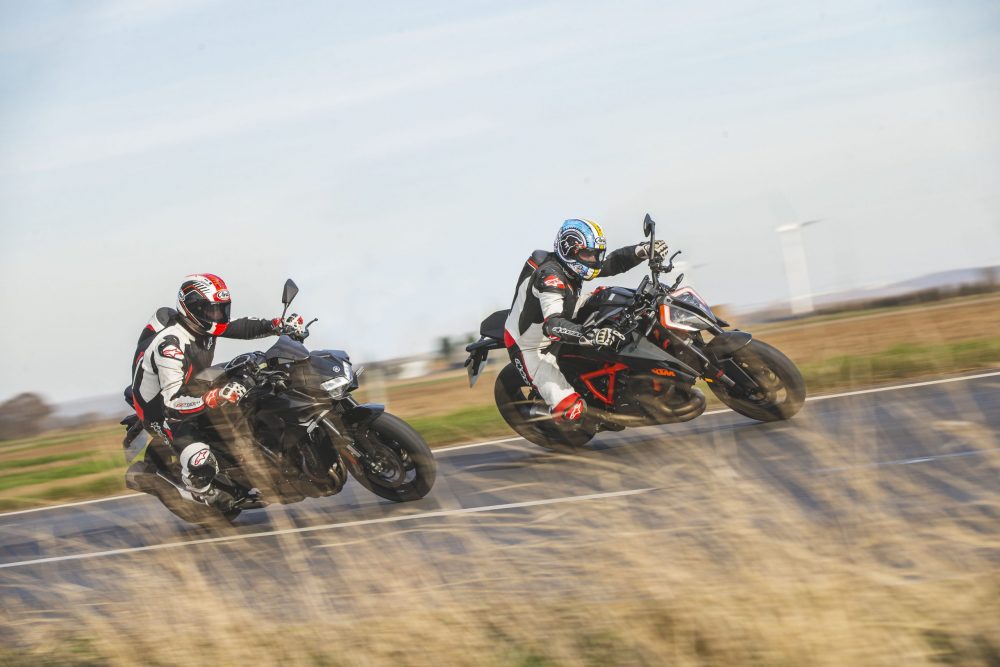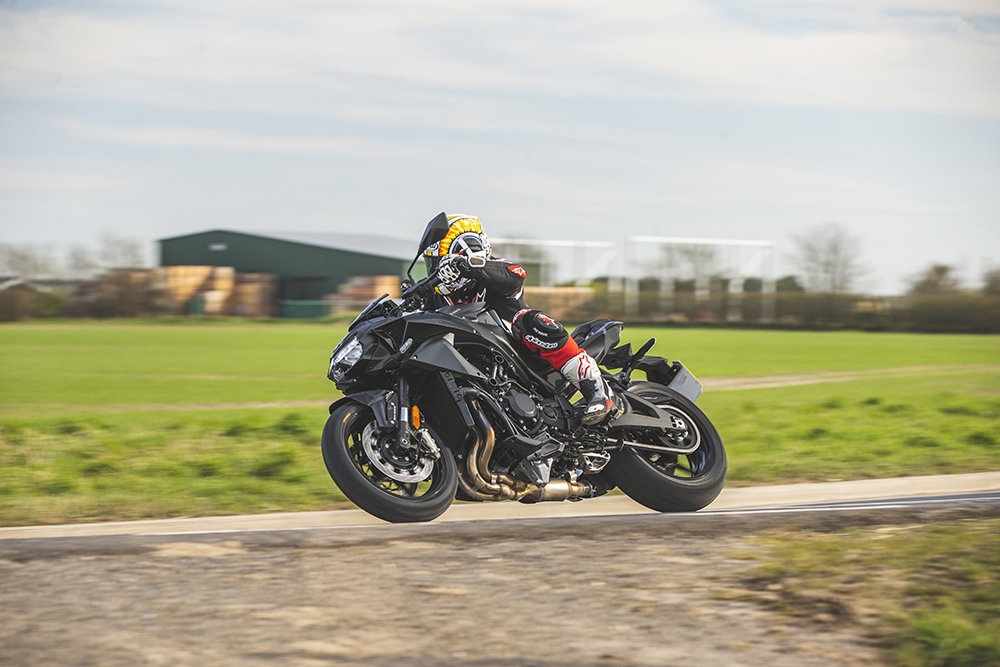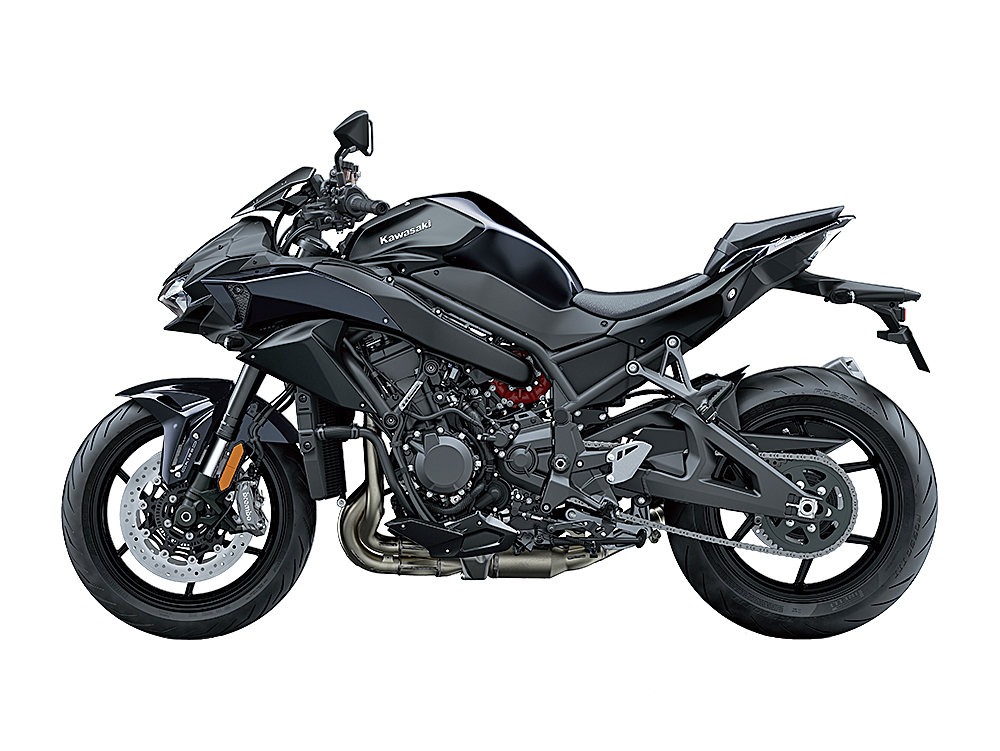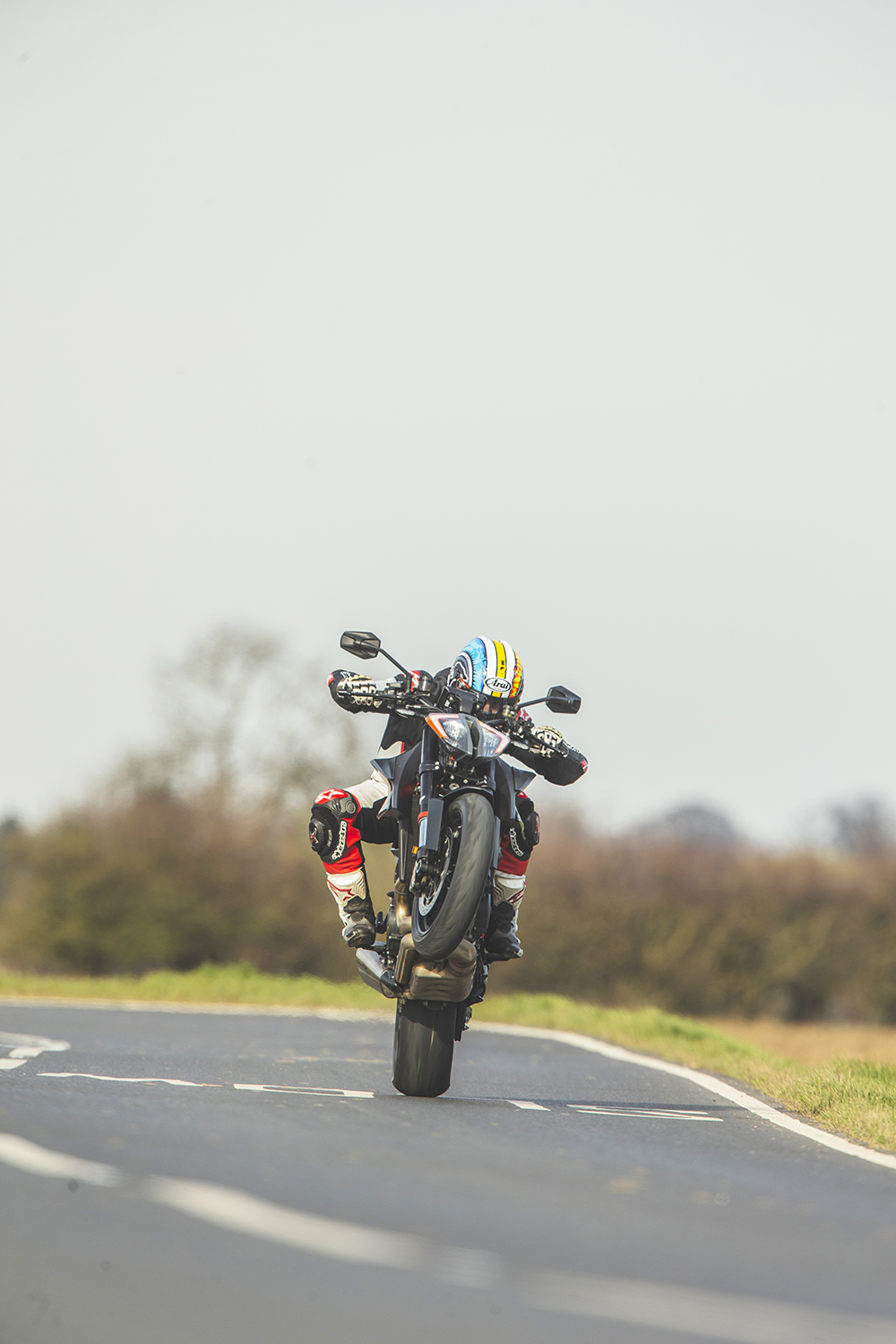Naturally aspirated big V-twin power from KTM or supercharged power from Kawasaki? We’re glad you asked
As the popularity of hard-edge sportsbikes decline, practical and high-powered nakedbikes have enjoyed a bit more time in the sun. Riders still want big performance, the latest rider aids and technology, but no longer want to pretend they’re Jonathan Rea or suffer the realities of hard seats and uncompromising ergonomics, which force your feet up near your backside.
This means the market is now brimming with attractive, aggressive, scaled-down naked offerings based on those once-popular sportsbikes, offering similar handling and performance to their racy relatives. In this field of exotica, two bikes stand out. They are not at the top end of this pricey sector, and neither is a scaled-down version of a racebike. There is no KTM superbike, and yes Kawasaki’s Z H2 has a sporty sibling, the formidable H2, but you’d never see a supercharged Kawasaki H2 leading a race; the Z H2 isn’t a scaled-down ZX-10R.
It’s an intriguing comparison as both manufacturers have chosen very different routes of development. KTM has built the KTM 1290 Super Duke R from the ground up. Now in its third incarnation in its current capacity, it has grown from 990cc to 1301cc in a bid to chase horsepower and stay Euro compliant.
Kawasaki, on the other hand, has attempted to climb Everest the hard way and is the only manufacturer to choose the supercharged route. Capacity remains at 998cc, but the supercharger puts it on a level playing field with the larger competition. But which would you want to see in your garage on a Sunday morning ahead of a blast to the coast? There’s only one way to find out.

Kawasaki Z H2
Kawasaki’s first supercharged bike, the H2 (and track-only H2R), was launched in Qatar in 2015, and I was one of the first riders outside Kawasaki to ride it (AMCN Vol 64 No 19). I still remember that first lap, tucked in down the 1km straight, flat out in sixth gear… the H2R was like nothing I’d experienced before – I managed a true 330km/h.
The road-legal 164kW (220hp) H2 was then refined and calmed to reshape into the H2 SX, Kawasaki’s sports-touring model launched in 2018 (AMCN Vol 68 No 03) and a bike which shares many similarities with the new naked Z H2. I first rode the SX around Portugal’s Estoril racetrack and was surprised how Kawasaki had managed to tame the sometimes overly aggressive H2. So I was looking forward to throwing a leg over the naked Z H2, which Pete tested recently (AMCN Vol 69 No 20) and which, according to Kawasaki, had been refined even further.
Essentially, by adopting the smaller-diameter supercharger impeller used in the SX, Kawasaki reduced the peak power of the Z H2 compared to the H2 while giving it more low to mid-range torque. The Z H2 also makes its peak power lower in the rev range than the H2 SX, but don’t worry, they haven’t added too much water to your wine. Quoted power is 147kW (197hp), just a bit over two kilowatts shy of Kawasaki’s ZX-10R, and peak torque is 137Nm at 8500rpm. But, with 30 percent more engine capacity, the KTM just edges out the Kawasaki in the torque bragging rights, producing 140Nm of torque, slightly lower in the rev-range.

Riding the Kawasaki for the first time, you can’t help but smile. No naturally aspirated engine gives you the excitement the Z H2 does – you know you’re in for something special. It feels like Christmas morning, every morning. Let the engine tick over, watch the engine temp and boost rise, give the throttle a few blips and listen to the chirp of the supercharger. The impeller-to-crank speed ratio of 9.2 is quick enough to break the sound barrier and create a brilliant chirping sound from around 6000rpm and upwards. It is most noticeable when you close the throttle at high rpm and it becomes highly addictive. The KTM maybe shouting ‘look at me’, but the Kawasaki’s chirp will have bikes fans flocking with admiration like seagulls to spilled chips.
All the headlines are about the engine, and it is hard to ignore. The Z H2 uses the SX’s 69mm diameter ‘balanced’ supercharger impeller to help deliver a huge tank of midrange torque and low to mid-range power. The result is instant thrust and it’s hard to keep tabs on initially. The rear tyre finds plenty of grip thanks to sophisticated electronics, so you just sit back and wait for the bike to try and rip your arms from their sockets. It’s a different experience to the KTM, which has more torque lower down and wants to pivot around the rear axle. Whereas the Kawasaki must have the supercharging spinning to create its power. The immense power of the supercharger will even take experienced riders by surprise, especially if they’ve not tasted supercharged power before.
Like a ZZR1400 or a Suzuki Hayabusa, it’s almost impossible to ride slowly and legally, it’s so much fun. It has bucketloads of torque, but you can’t help but dance on the quickshifter to get the supercharger spinning again, which results in eyeball popping acceleration. Crack the throttle in second gear and 160km/h comes and passes all too easily. Keep tapping the quickshifter and it feels like the only limits to your speed are your arms and neck muscles. You have been warned.

But there is a flip side to the new Z H2. Flick it into one of the softer rider modes and the angry tiger transforms into a lazy house cat. The throttle response evens out, so smooth in fact a relatively new rider could jump on the Z H2, ride to the shops and back and not feel intimidated, whereas the KTM aggressive nature and stance are a constant reminder of its lethal bite. The original H2 was a bit sharp on the throttle to put it mildly but, as with the H2 SX, that has been completely addressed on the Z H2. It really does have two personalities, angry arm-ripping supercharged animal one minute; user friendly and relatively easy the next.
At a claimed 236kg, the Z H2 isn’t light, but in Kawasaki’s defence it was never described or intended to be. On the track, the lighter KTM with less power would show the Kawasaki a clean pair of heels if the track was twisty enough. The KTM feels considerably lighter, flickable and sportier, way ahead of the big Kawasaki. However, despite the on-paper weight, the Z H2 carries its kilos well – the suspension copes, and the extra kilos add stability and a sense of reassurance, which is lacking on the KTM. The only downside is the bike’s physical girth; it’s noticeably wide around the fuel tank, which is a constant reminder of the weight of the bike.
But Kawasaki stresses this isn’t a trackbike, and on the road the handling is impressive, stable and predictable. Even at a brisk pace I had few complaints, while the Pirelli Rosso 3 tyres gave great feedback at knee-down levels of lean. On a trackday, I’d want to play with the suspension to get the right set up, but for 90 percent of the time the ‘showroom’ set up works. According to the digital readout on the new TFT dash, I achieved 47 degrees of lean to the right and 45 to left, and it still felt planted while ground clearance wasn’t an issue on the road. I’m guessing very few owners will venture on track, whereas KTM owners will be more likely to be battering down the doors of their local racetrack.
Obviously, with so much power, Kawasaki had to heavily invest in up-to-date rider aids, and the firm has delivered. There are four rider modes – Sport, Road Rain, and a specific Rider mode which lets you pick and mix the settings to your personal taste. You can even turn off the traction control if you’re brave enough. The pre-programmed rider modes change the engine power, its character and traction control intervention. The rider aids are changeable on the move, and everything is clearly displayed on the latest TFT full-colour dash.

The electronics are excellent, sophisticated and hard working – they have to be on a bike that will try to lift the front wheel in the first three gears – but the intervention is smooth, not dramatic; control. The Z H2 has launch control, cruise control, cornering ABS and a multidirectional quickshifter. Despite costing less than the KTM, the Kawasaki comes with higher-spec electronics as standard, and the extra information like lean angle clearly displayed in the dash is as addictive as the supercharger’s chirp.
The only negative aspect is the new switchgear, which takes a little getting used to, and it seems to take forever to change modes on the move. Actually, I’ve seen glaciers melt quicker.
Looks are subject to interpretation, but the fan club for the Z H2’s styling is small. I wouldn’t describe the Kawasaki as ugly, but it’s certainly not going to be to everyone’s taste. Personally, I like some aspects of the bike, the non-symmetrical face and huge air-duct on one side of the headlight in particular. The trellis frame not only keeps the motor cool but looks attractive. The Z H2, like all recent bikes from Kawasaki, has a feeling of quality. But I’m unsure about the look of the front end, the verdict is still out. The KTM also splits opinion on styling, some love it some hate it, and even though it’s a significant update over the old model, it doesn’t visually appear so.
And while $23,000 (plus on-road costs) is a lot of money, it’s cheaper than the KTM at $26,195 and in standard form has a higher spec than the KTM. The downside to the supercharged Zed is its running costs. A rear tyre is going to last about 3000 kays if ridden hard. Then there is the fuel consumption; get the supercharger spinning and it will drink quicker than an alcoholic at happy hour.

KTM 1290 Super Duke R
When KTM launched its first Super Duke it was just 998cc in capacity, the V-twin produced a nose over 89kW (120hp) and tipped the scales at a mere 179kg. In 2005 this was incredible, a revelation.
It had its faults – poor fuelling and fuel consumption – but it was a fresh injection of madness into the motorbike world. This was Gene Simmons partying hard in full makeup. I raced one in the one-make series which supported the British Superbike series; it was crazy and so much fun.
KTM has kept that simple DNA right through the Super Duke’s evolution, increasing power over the years, adding rider aids and technology, but maintaining the same attitude of the original bike – it was and, in many ways still is, the bike that wanted to throw a TV out of a hotel window, or drive a Rolls Royce into a pool.
In 2014 KTM introduced the first 1290 Super Duke, nicknamed The Beast. I rode it – alongside former AMCN staffer Alex Penklis at the world launch in Ascari (AMCN Vol 63 No 09) and it certainly lived up to the name. In 2017 KTM tweaked and tamed the beast, but now it’s time for the third generation.
For 2020 KTM is claiming the bike is 90 percent new, even though it looks very similar to its predecessor. These changes have obviously been forced upon KTM to make the bike Euro-5 compliant, but instead of simply adding a couple of cat-converters, KTM has seen this as an opportunity for a full re-vamp.

Despite cleaning up the emissions, KTM has increased power and reduced weight – something rarely achieved by other manufacturers. Claimed power is now up a couple of kilowatts to 132kW (177hp), and torque is a fraction down at 140Nm, still more than the supercharged Kawasaki.
Every aspect of the bike has been reviewed and improved if possible: wheels, brakes, bodywork, chassis and electronics. The chassis is three times stiffer, but lighter. The subframe is all-new and again lighter. Geometry has changed with a longer wheelbase, more offset and reduced trail, which increases ground clearance and should dramatically sharpen the steering.
The rear shock is all-new and features a nice remote preload adjuster; there’s a new linkage, the pivot point is higher and the WP 48mm fully-adjustable fork is new, too. Overall the bike is six kilograms lighter, which is really impressive on an already light bike, now topping the scales at a quoted 189kg dry. Even fully fuelled, now via a 16L tank rather than the 18L version on the outgoing model, estimated weight will be around 205kg, around 34kg lighter than the Kawasaki. And because most of these improvements have been introduced to make ‘The Beast’ lighter and more powerful – but also easier to live with – it makes the Kawasaki appear even more on the hefty side when you ride them back to back. Just lifting it from the side-stand is easier.
Straight away you notice the differences on the big Kato. New switchgear and a full-colour TFT dash which is easier and simpler to navigate than previously. I wasn’t a fan of the first-generation dash and switchgear, and the redesigned system is better. However, I’m unsure if it’s just me – bearing in mind I struggle to wind my clock back for daylight saving – but I’d prefer something a little more intuitive for navigating the dash. Only by the end of a long day in the saddle had the Super Duke and I started to click. To be fair, that was without reading the manual or asking any KTM staff for help…
Our test model came with the optional Tech Pack, which incorporates all the software upgrades and saves money compared to buying them separately. It includes a quickshifter, MSR, adaptive brake light (flashes when breaking heavily) and the Track pack. The Track Pack also includes two more rider modes – track mode and performance mode – and the ability to switch off the wheelie control, plus launch control, traction control slip adjust, and throttle response selection. I guess it all depends on what you want from your Super Duke.

If you just intend to ride on the road, keep the rider aids active and your licence intact, then the standard bike is fine. But for the hooligans or trackday regulars the Tech Pack throws all the electronic upgrades into one affordable package.
In the interest of professionalism, I tried to ride the KTM legally and normally, even riding in the bike’s Rain mode, which reduces power to 97kW (130hp). But even at these sedate, legal speeds, you immediately notice the difference between the 2020 bike and its predecessor. The ride feels plusher, which is likely down to the change in the rear linkage, not as harsh as the previous model, and closer to the smooth ride of the Kawasaki. The steering feels more natural, there is less effort to get the bike to steer, while it’s more responsive than previously. Again, this is a combination of new geometry, suspension and reduced weight.
For a bike that has a larger engine than my first car, it’s incredibly light, especially when compared to the Kawasaki. Comparing the two is like comparing a lumbering heavyweight boxer like Tyson Fury to Nigel Benn, a lean mean middleweight fighting machine. It’s incredibly nimble.
As hard as I tried, I couldn’t ride the KTM in rain mode for long, it’s like going to an Iron Maiden concert wearing earplugs and a suit. The Super Duke is designed to be fun, so let it run, and boy does it deliver – it’s crazy. There is so much instant torque, even from as low as 3000rpm. It just wants to find grip and accelerate – I love it. You don’t need to rev the KTM, just tap on the quickshifter and, bang, another tidal wave of torque hits you again.
In the low to midrange, it’s hard to see any other bike being able to hang onto the KTM, even the supercharged Kawasaki. In the first three gears the Duke wants to lift the front wheel skyward. Rev it hard and it feels like the huge pistons are running freely without any resistance. The KTM is quick, arguably ‘feels’ quicker than the Z H2, as it is more physical, and the power kicks in lower down.
But the big advantage it has over older Super Dukes is its electronics. Previously, when the traction control kicked in it felt harsh, especially on the first variant, which slammed you into the fuel tank every time the traction cut in. Now there is much more refinement, it’s a fine wine rather than a pint of bitter.

With the rider aids activated it allows the front to lift, dependant on which mode it’s in, but it’s more like a hovering power wheelie rather than an oh no! moment. With the rider aids turned off, wheelies are controllable with a precise and accurate throttle, the snatchy throttle at low revs you’d normally associate with a large V-twin all but a memory. The new Super Duke has to be the easiest bike on the market to wheelie, with control. Yes, the Kawasaki will perform the same immature trick, but it’s simpler on the KTM.
When the pace hots up, the handling is there to match the power. The chassis is precise, you can hit the same apex time and time again, bang on the money. The understeer the old bike suffered did show its ugly head on the road this time, but the suspension and tyres give excellent feedback, boosting confidence, enabling you to corner faster with more lean.
The KTM always feels one or maybe two steps ahead of the Kawasaki when it comes to the twisties – knee down into corners felt natural on the KTM, but on the Kawasaki it was a little more reluctant. The Brembo stoppers are superb, again with less weight the KTM outclassed the Kawasaki in this department, while the Supermoto mode added another element of fun.
As with the Z H2, running costs are going to be high. Rear tyres aren’t going to last long, it’s thirsty and now the tank capacity has dropped, range will be limited, probably to 160-odd kays if ridden hard. The Super Duke doesn’t have the comfort the Kawasaki can boast, despite having an adjustable riding position, and I’d hate to be a pillion. But then again, if you’re looking for practicality, orange isn’t your colour.

Conclusion
Both bikes offer power and performance we wouldn’t have imagined possible from a naked bike 10 years ago. The limitation isn’t the engine but how strong your arms are. Both also offer unquestionable fun and thrills but in different ways. I can see the Z H2 appealing to Hayabusa and ZX-14R owners, a B-King for 2020. It’s more refined than the KTM, with immense power, and the supercharger is very addictive.
Anyone wanting more excitement, possibly moving from a sportsbike or trackday bike, will prefer the KTM. It’s still enormous fun, has the DNA of the original hooligan, but it’s grown up a little, and, arguably, no longer wants to throw the TV out of the hotel window.

Test Adam Child
Photography Simon Lee